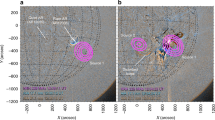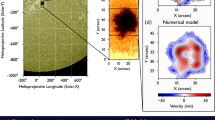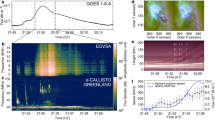Abstract
Observations of velocity waves from the 5-min p-mode oscillations in the solar sub-photospheric cavity have permitted a number of important inferences about physical conditions and differential rotation in the solar interior1. Models also predict the existence of an overlying acoustic cavity, defined by reflections between the temperature minimum and the sharp rise from chromospheric to coronal temperatures2–5. Observations of chromospheric emission features6,7, the cores of strong absorption lines8–11 and the far-infrared continuum12 have established that chromospheric oscillatory power is shifted to higher frequencies than is the case for the sub-photospheric cavity. However, it remains to be established that this oscillatory power is sufficiently localized to indicate the presence of resonant modes at frequencies close to the predicted eigenfrequencies. We have obtained time-series observations of an infrared (11-µm) solar OH absorption line profile, on two consecutive days, using a laser heterodyne spectrometer to view a 2-arc-s portion of the quiet Sun at disk centre. A power spectrum of the line-centre velocity shows the well-known photospheric p-mode oscillations very prominently, but also shows a second feature near 4.3 mHz. A power spectrum of the line intensity shows only the 4.3-mHz feature, which we identify as the fundamental (n = 1) p-mode resonance of the solar chromosphere. The frequency of the mode is observed to be in substantial agreement with the eigenfrequency of current chromospheric models. A time series of two beam difference measurements shows that the mode is present only for horizontal wavelengths > 19 Mm. The period of a chromospheric p-mode resonance is directly related to the sound travel time across the chromosphere, which depends on the chromospheric temperature and geometric height. Thus, detection of this resonance will provide an important new constraint on chromospheric models.
This is a preview of subscription content, access via your institution
Access options
Subscribe to this journal
Receive 51 print issues and online access
$199.00 per year
only $3.90 per issue
Buy this article
- Purchase on Springer Link
- Instant access to full article PDF
Prices may be subject to local taxes which are calculated during checkout
Similar content being viewed by others
References
Christensen-Dalsgaard, J., Gough, D. & Toomre, J. Science 229, 923–931 (1985).
Bahng, J. & Schwarzschild, M. Astrophys. J. 137, 901–913 (1963).
Ando, H. & Osaki, Y. Publs astr. Soc. Japan 29, 221–233 (1977).
Ulrich, R. K. & Rhodes, E. J. Jr Astrophys. J. 218, 521–529 (1977).
Christensen-Dalsgaard, J. & Frandsen, S. Sol. Phys. 82, 165–204 (1983).
Orrall, F. Q. Astrophys. J. 143, 917–927 (1966).
Athay, R. G. & White, O. R. Astrophys. J. Suppl Ser. 39, 333–346 (1979).
Cram, L. E. Astr. Astrophys. 70, 345–354 (1978).
Kneer, F., Newkirk, G. Jr & von Uexkull, M. Astr. Astrophys. 113, 129–134 (1982).
Dame, F., Gouttebroze, P. & Malherbe, J. M. Astr. Astrophys. 130, 331–340 (1984).
von Uexkull, M., Kneer, F., Mattig, W., Nesis, A. & Schmidt, W. Astr. Astrophys. 146, 192–194 (1985).
Lindsey, C. & Kaminski, C. Astrophys. J. 282, L103–L106 (1984).
Glenar, D., Deming, D., Espenak, F., Kostiuk, T. & Mumma, M. J. Appl. Opt. 25, 58–62 (1986).
Deming, D., Hillman, J. J., Kostiuk, T., Mumma, M. J. & Zipoy, D. M. Sol. Phys. 94, 57–74 (1984).
Deeming, T. J. Astrophys. Space Sci. 36, 137–158 (1975).
Leibacher, J., Gouttebroze, P. & Stein, R. F. Astrophys. J. 258, 393–403 (1982).
Noyes, R. W. & Leighton, R. B. Astrophys. J. 138, 631–647 (1963).
Author information
Authors and Affiliations
Rights and permissions
About this article
Cite this article
Deming, D., Glenar, D., Käufl, H. et al. Infrared helioseismology: detection of the chromospheric mode. Nature 322, 232–234 (1986). https://doi.org/10.1038/322232a0
Received:
Accepted:
Issue Date:
DOI: https://doi.org/10.1038/322232a0
This article is cited by
-
A possible presence of HeH+ in white dwarfs
Astrophysics and Space Science (1992)
-
Ca ii H2v and K2v cell grains
Solar Physics (1991)
-
New light on solar infrared intensity oscillations
Solar Physics (1990)
-
Sunspot umbral oscillations in Mgii k
Solar Physics (1987)
Comments
By submitting a comment you agree to abide by our Terms and Community Guidelines. If you find something abusive or that does not comply with our terms or guidelines please flag it as inappropriate.



